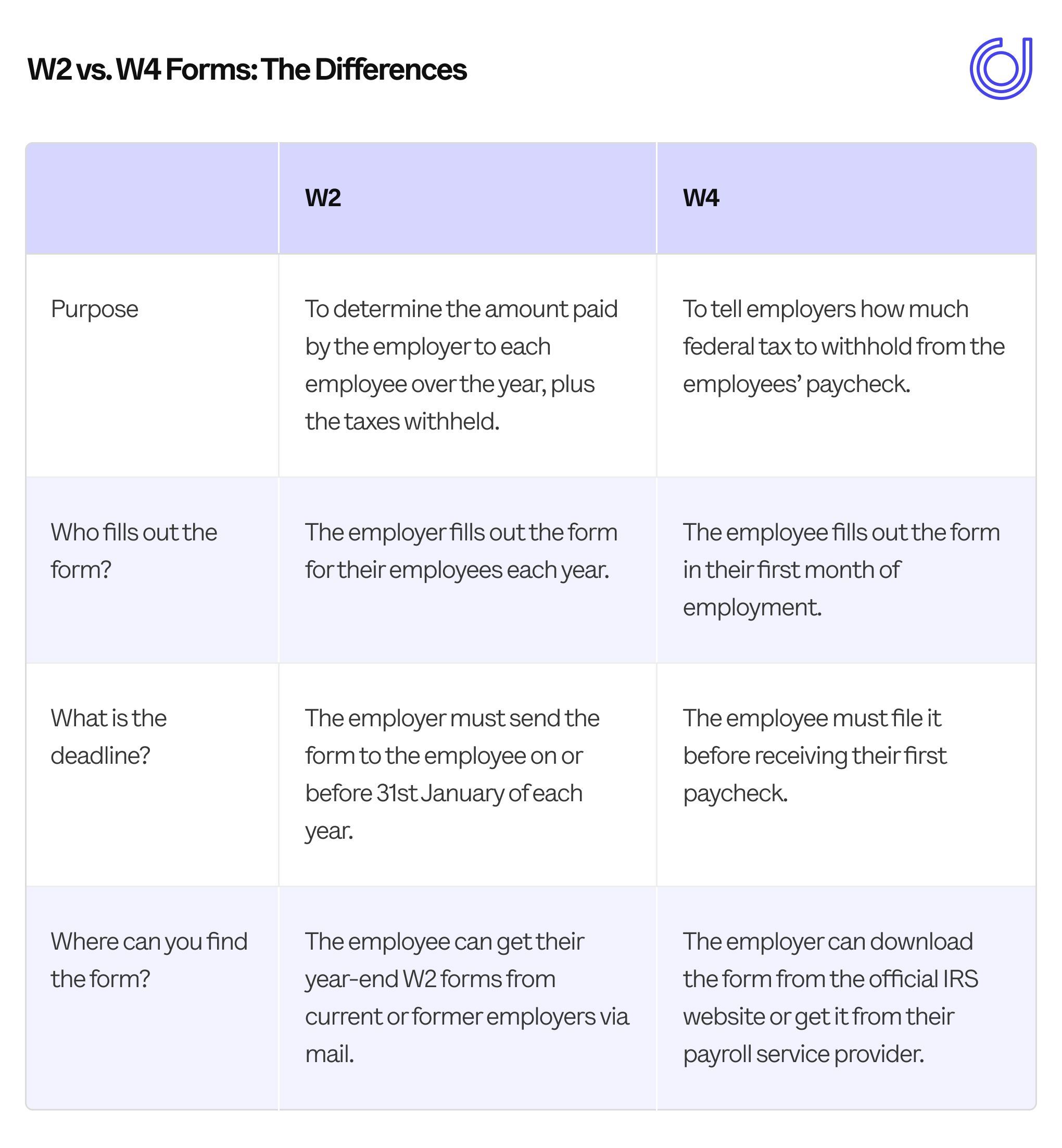Personal Finance
•
10 mins read
•
October 08, 2021
Form W2 vs. Form W4: What's the Difference?
The definitive guide to help you compare the W2 and W4 tax forms — including their uses and how to fill them out correctly for your business.

Although many different tax forms are required throughout the business year, two of the most common are the W2 and W4 forms.
The W2 and W4 forms are crucial IRS documents that have a direct impact on your tax liability. Understanding the differences between the two can go a long way toward ensuring tax compliance.
However, for many new company owners and employees who are starting their jobs, these forms tend to cause a lot of confusion.
So, no matter whether you’re filing these forms for the first time or the tenth time, this guide will help you better understand what to expect.
W2 vs. W4 Forms: What are the Differences?
Form W2: An Overview
Officially known as IRS Form W2 Wage and Tax Statement, W2 is a
that reports how much an individual employee has earned (including bonuses and tips) and their contributions to the federal taxes, retirement plans, and Social Security and Medicare taxes.

What is Form W2 Used For?
Employers submit the Form W2 for each employee that they have paid throughout the calendar year. Once completed, a copy is sent to the
(IRS),
(SSA), and the employee.
The employee requires this form to file their year-end tax returns before the deadline, which is April 15 in most years. The IRS uses this form to track taxpayer’s wages and tax obligations. The SSA also uses it to calculate the employee’s Social Security benefits.
When is Form W2 Due?
Every employer must send the W2 form to all their employees, the IRS, and the SSA on or before 31st January of each year. Otherwise, they face a W2 filing penalty. This gives the employees ample time to fill out their personal tax returns.
Form W4: An Overview
, also known as the Employee’s Withholding Allowance Certificate, is filed by the employee after accepting their employment offer. New hires should correctly complete the W4 form on their first day of employment, or at least before their first paycheck.
Existing employees also have to update the W4 form every year if there are any personal or professional changes, such as marriage, having a child, having more than one job, and so on.
What is Form W4 Used For?
Employers use Form W4 to calculate how much federal, state, and local taxes to withhold from an employee’s paycheck for the IRS. The amount is based on their wages and the number of allowances the employee is eligible for.
The number of allowances depends on the employee’s marital status and the number of dependents they have. A single person will have a lower tax allowance, so more tax will be withheld. A single mom with two children will have a higher allowance, so it’s good to withhold less tax.
When is Form W4 Due?
The W4 form is not filed directly with the IRS. After using it to determine the tax withholding, the employer will submit it to the IRS, along with the employee’s information, such as their name, address, Social Security number, and so on.
The employees need to complete the W4 form before they get their first salary, if not before.
Differences Between Form W2 and Form W4
Now that you’re aware of how the W2 vs. W4 forms work, let’s compare the two.

How to Fill in Form W2
The employer is solely responsible for completing and filing W2 forms for each of their employers annually. To complete the W2 form, employers will have to input the following information, either by hand or electronically:
- Employer’s name, address, and ZIP code;
- Employee’s name, address, and ZIP code;
- Employer identification number (EIN);
- Employee’s wages and tax withholdings.
Once the forms are complete, file them with the SSA and distribute them to the employees, no later than 31st January of every year.
What information you include in the form depends on your business and individual employees. For example, the retirement plan and dependent care benefits might not apply to every employee, and therefore, might not be included in every W2 form.
Remember, employers can file W2 forms only for their employees, not for freelancers or contractors.
How to Fill in Form W4
Every new employee needs to fill out and submit the W4 form before receiving their first paycheck. The SSA recommends filing W4s electronically due to increased accuracy and efficiency, but they can be filed physically as well.
As an employer, you cannot tell your employees what to include in the form but only guide them on how to calculate their correct withholdings. Plus, the employees can use an IRS tax withholding calculator to estimate how much of their
will be withheld.
The information the employee needs to provide includes:
- Name and address;
- Social Security Number (SSN);
- The number of allowances they can claim;
- Marital status at the time of filing the form - single or married;
- Whether they’re exempt from making tax payments;
- Any additional amount they wish to have withheld from their salary to decrease the tax amount they pay at the end of the year.
Once the employee completes the W4 form, they’ll submit it to the employer. The employer must input the information in the payroll system to ensure the correct tax amount is withheld from each employee's paycheck.
W2 vs. W4 Forms: FAQs
- How much money does an employee need to make to get a W2? Only employees who have earned at least $600 in a given year will receive a W2 form from the employer.
- What to do if an employee loses their W2 or W4 form? If the form is available online, they can access it as many times as they want. If the password or login credentials are lost, employees can request an automated password recovery or a new paper copy from the payroll or HR supervisor.
- What’s the difference between Forms W2 and 1099? Form W2 reports the amount earned and tax withholding for every full-time employee, while Form 1099 reports payments made to freelancers and contractors. Employers do not withhold any tax amount from the contractor’s payments as they are responsible for paying the correct tax amount on their own.
Bottom Line
While W2 and W4 forms are crucial IRS tax documents for every business, both have a distinct purpose. Knowing how these forms work and explaining the differences to employees can help the company streamline its W2 vs. W4 form filing processes.
Don’t wait until the last minute to submit these forms, as it can lead to errors or missed deadlines. Plus, you can even face a late penalty from the IRS for W2s. The employers will be liable to pay a penalty of $50 per form if you file it within 30 days of the due date. The maximum penalty is $536,000 per year or $187,500, if you run a small business.
And, as always, if you still have doubts, consult a tax advisor to help you fill things out.
Good luck!


